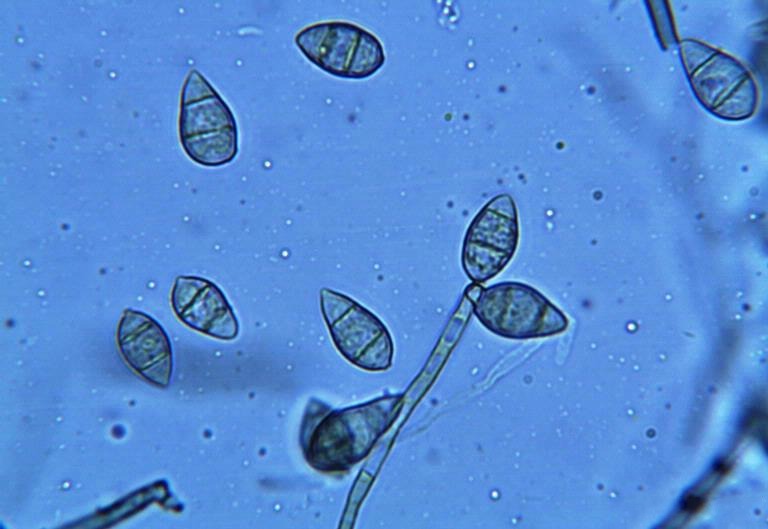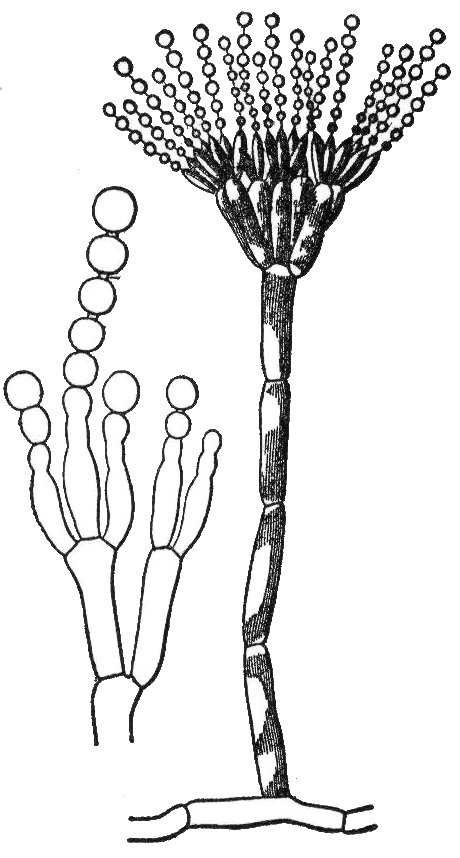|
Gray Leaf Spot
Gray leaf spot (GLS) is a foliar fungal disease that affects grasses. In grasses other than maize it is caused by '' Pyricularia grisea'', which only infects perennial ryegrass, tall fescue, and St. Augustine grass in places with warm and rainy climates. Symptoms Early symptoms of gray leaf spot can be seen on leaves as small, spherical lesions with a yellow halo around them. These first lesions may be tan or brown before fungal sporulation begins. The initial disease can be hard to identify as gray leaf spot at this stage because it looks similar to eyespot and common rust. However, as the lesions mature they elongate into rectangular, narrow, brown to gray spots that usually develop on the lower leaves and spread upward on the plant during the season. The lesions elongate and expand parallel to the leaf veins and can be 1.5 to 2 inches long. With favorable weather the lesions can rapidly merge and kill the entire leaf. Mature gray leaf spot symptoms can also be confused with ... [...More Info...] [...Related Items...] OR: [Wikipedia] [Google] [Baidu] |
Pyricularia Grisea
''Magnaporthe grisea'', also known as rice blast fungus, rice rotten neck, rice seedling blight, blast of rice, oval leaf spot of graminea, pitting disease, ryegrass blast, Johnson spot, neck blast, wheat blast and , is a plant-pathogenic fungus and model organism that causes a serious disease affecting rice. It is now known that ''M. grisea'' consists of a cryptic species complex containing at least two biological species that have clear genetic differences and do not interbreed. Complex members isolated from ''Digitaria'' have been more narrowly defined as ''M. grisea''. The remaining members of the complex isolated from rice and a variety of other hosts have been renamed ''Magnaporthe oryzae'', within the same ''M. grisea'' complex. Confusion on which of these two names to use for the rice blast pathogen remains, as both are now used by different authors. Members of the ''M. grisea'' complex can also infect other agriculturally important cereals including wh ... [...More Info...] [...Related Items...] OR: [Wikipedia] [Google] [Baidu] |
Lolium Perenne
''Lolium perenne'', common name perennial ryegrass, English ryegrass, winter ryegrass, or ray grass, is a grass from the family Poaceae. It is native to Europe, Asia and northern Africa, but is widely cultivated and naturalised around the world. Description The plant is a low-growing, tufted, hairless grass, with a bunching (or tillering) growth habit. The leaves are dark green, smooth and glossy on the lower surface, with untoothed parallel sides and prominent parallel veins on the upper surface. The leaves are folded lengthwise in bud (unlike the rolled leaves of Italian ryegrass, ''Lolium multiflorum'') with a strong central keel, giving a flattened appearance. The ligule is very short and truncated and often difficult to see. The small white auricles grip the stem at the base of the leaf blade. Leaf sheaths at the base are usually tinged pink and hairless. Stems grow up to 90 cm. The inflorescence is unbranched, with spikelets on alternating sides edgeways-on to the s ... [...More Info...] [...Related Items...] OR: [Wikipedia] [Google] [Baidu] |
Festuca Arundinacea
''Lolium arundinaceum'', commonly known as tall fescue, is a cool-season, perennial C3 grass species native to Europe and introduced to North America and other parts of the world. It naturally occurs in grasslands and coastal marshes.Texas Parks and Wildlife Department (n.d.). Tall Fescue (''Lolium arundinaceum''). Texas Invasive Plant Database/ref> Tall fescue is grown in a range of Cultivar, cultivars, widely used for livestock forage, in lawns and recreational areas as turf, and occasionally for managing soil erosion. Most publications have used the names ''Festuca arundinacea'' or, more recently, ''Schedonorus arundinaceus'' for this species, but DNA studies appear to have settled a long debate that it should be included within the genus ''Lolium'' instead. Description Tall fescue is a long-lived tuft-forming perennial with erect to spreading hollow flowering stems up to about tall (exceptionally up to 200 cm) which are hairless (glabrous), including the leaf sheath ... [...More Info...] [...Related Items...] OR: [Wikipedia] [Google] [Baidu] |
Ascomycota
Ascomycota is a phylum of the kingdom Fungi that, together with the Basidiomycota, forms the subkingdom Dikarya. Its members are commonly known as the sac fungi or ascomycetes. It is the largest phylum of Fungi, with over 64,000 species. The defining feature of this fungal group is the "ascus" (), a microscopic sexual reproduction, sexual structure in which nonmotile spores, called ascospores, are formed. However, some species of Ascomycota are Asexual reproduction, asexual and thus do not form asci or ascospores. Familiar examples of sac fungi include morels, truffles, yeast#Beer, brewers' and bakers' yeast, Xylaria, dead man's fingers, and cup fungi. The fungal symbionts in the majority of lichens (loosely termed "ascolichens") such as ''Cladonia'' belong to the Ascomycota. Ascomycota is a monophyletic group (containing all of the descendants of a common ancestor). Previously placed in the Basidiomycota along with asexual species from other fungal taxa, asexual (or Teleomorph, ... [...More Info...] [...Related Items...] OR: [Wikipedia] [Google] [Baidu] |
Anamorph
In mycology, the terms teleomorph, anamorph, and holomorph apply to portions of the life cycles of fungi in the phyla Ascomycota and Basidiomycota: *Teleomorph: the sexual reproductive stage (morph), typically a fruiting body. *Anamorph: an asexual reproductive stage (morph), often mold-like. When a single fungus produces multiple morphologically distinct anamorphs, these are called synanamorphs. *Holomorph: the whole fungus, including anamorphs and teleomorph. The terms were introduced in 1981 to simplify the discussion of the procedures of the existing dual-naming system, which (1) permitted anamorphs to have their separate names but (2) treated teleomorphic names as having precedence for being used as the holomorphic name. The ''Melbourne Code'' removes the provisions and allows all names to compete on equal footing for priority as the correct name of a fungus, and hence does not use the term ''holomorph'' any more. Dual naming of fungi Fungi are classified primarily based o ... [...More Info...] [...Related Items...] OR: [Wikipedia] [Google] [Baidu] |
Perithecium
An ascocarp, or ascoma (: ascomata), is the fruiting body ( sporocarp) of an ascomycete phylum fungus. It consists of very tightly interwoven hyphae and millions of embedded asci, each of which typically contains four to eight ascospores. Ascocarps are most commonly bowl-shaped (apothecia) but may take on a spherical or flask-like form that has a pore opening to release spores (perithecia) or no opening (cleistothecia). Classification The ascocarp is classified according to its placement (in ways not fundamental to the basic taxonomy). It is called ''epigeous'' if it grows above ground, as with the morels, while underground ascocarps, such as truffles, are termed ''hypogeous''. The structure enclosing the hymenium is divided into the types described below (apothecium, cleistothecium, etc.) and this character ''is'' important for the taxonomic classification of the fungus. Apothecia can be relatively large and fleshy, whereas the others are microscopic—about the size of ... [...More Info...] [...Related Items...] OR: [Wikipedia] [Google] [Baidu] |
Ascospore
In fungi, an ascospore is the sexual spore formed inside an ascus—the sac-like cell that defines the division Ascomycota, the largest and most diverse Division (botany), division of fungi. After two parental cell nucleus, nuclei fuse, the ascus undergoes meiosis (halving of genetic material) followed by a mitosis (cell division), ordinarily producing eight genetically distinct haploid spores; most yeasts stop at four ascospores, whereas some moulds carry out extra post-meiotic divisions to yield dozens. Many asci build turgor, internal pressure and shoot their spores clear of the calm boundary layer, thin layer of still air enveloping the fruit body, whereas subterranean truffles depend on animals for biological dispersal, dispersal. Ontogeny, Development shapes both form and endurance of ascospores. A hook-shaped crozier aligns the paired nuclei; a double-biological membrane, membrane system then parcels each daughter nucleus, and successive wall layers of β-glucan, chitosan ... [...More Info...] [...Related Items...] OR: [Wikipedia] [Google] [Baidu] |
Magnaporthe Grisea
''Magnaporthe grisea'', also known as rice blast fungus, rice rotten neck, rice seedling blight, blast of rice, oval leaf spot of graminea, pitting disease, ryegrass blast, Johnson spot, neck blast, wheat blast and , is a plant-pathogenic fungus and model organism that causes a serious disease affecting rice. It is now known that ''M. grisea'' consists of a cryptic species complex containing at least two biological species that have clear genetic differences and do not interbreed. Complex members isolated from '' Digitaria'' have been more narrowly defined as ''M. grisea''. The remaining members of the complex isolated from rice and a variety of other hosts have been renamed ''Magnaporthe oryzae'', within the same ''M. grisea'' complex. Confusion on which of these two names to use for the rice blast pathogen remains, as both are now used by different authors. Members of the ''M. grisea'' complex can also infect other agriculturally important cereals including ... [...More Info...] [...Related Items...] OR: [Wikipedia] [Google] [Baidu] |
Conidium
A conidium ( ; : conidia), sometimes termed an asexual chlamydospore or chlamydoconidium (: chlamydoconidia), is an Asexual reproduction, asexual, non-motility, motile spore of a fungus. The word ''conidium'' comes from the Ancient Greek word for dust, ('). They are also called mitospores due to the way they are generated through the cellular process of mitosis. They are produced exogenously. The two new haploid cells are genetically identical to the haploid parent, and can develop into new organisms if conditions are favorable, and serve in biological dispersal. Asexual reproduction in ascomycetes (the phylum Ascomycota) is by the formation of conidia, which are borne on specialized stalks called conidiophores. The Morphology (biology), morphology of these specialized conidiophores is often distinctive between species and, before the development of molecular techniques at the end of the 20th century, was widely used for identification of (''e.g.'' ''Metarhizium#Species, Metarh ... [...More Info...] [...Related Items...] OR: [Wikipedia] [Google] [Baidu] |
Irrigation
Irrigation (also referred to as watering of plants) is the practice of applying controlled amounts of water to land to help grow crops, landscape plants, and lawns. Irrigation has been a key aspect of agriculture for over 5,000 years and has been developed by many cultures around the world. Irrigation helps to grow crops, maintain landscapes, and revegetation, revegetate disturbed soils in dry areas and during times of below-average rainfall. In addition to these uses, irrigation is also employed to protect crops from frost, suppress weed growth in grain fields, and prevent soil consolidation. It is also used to cool livestock, reduce dust, dispose of sewage, and support mining operations. Drainage, which involves the removal of surface and sub-surface water from a given location, is often studied in conjunction with irrigation. There are several methods of irrigation that differ in how water is supplied to plants. Surface irrigation, also known as gravity irrigation, is the olde ... [...More Info...] [...Related Items...] OR: [Wikipedia] [Google] [Baidu] |





